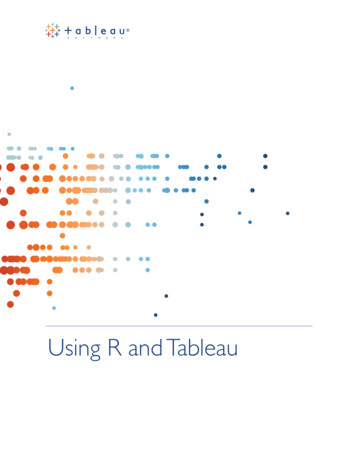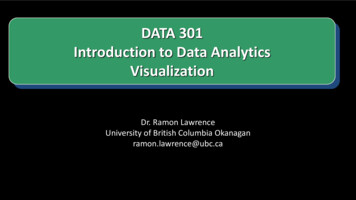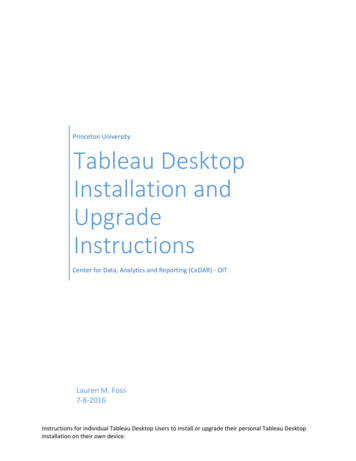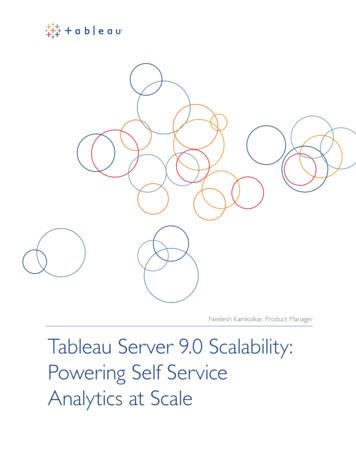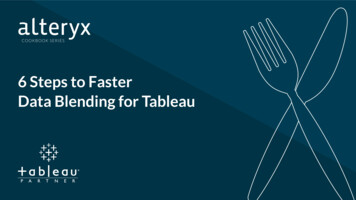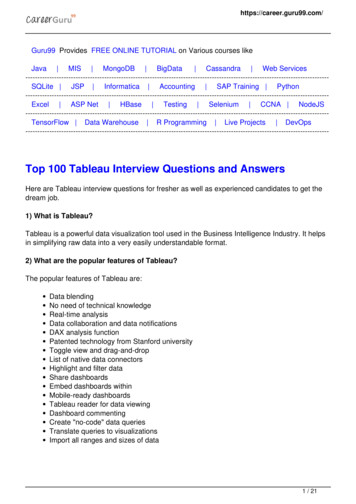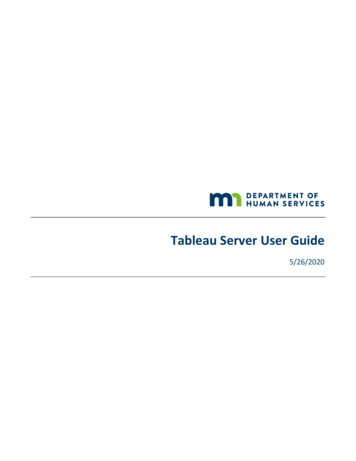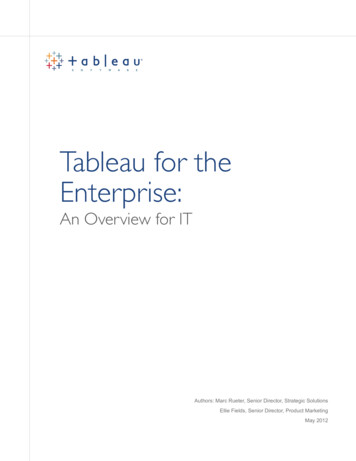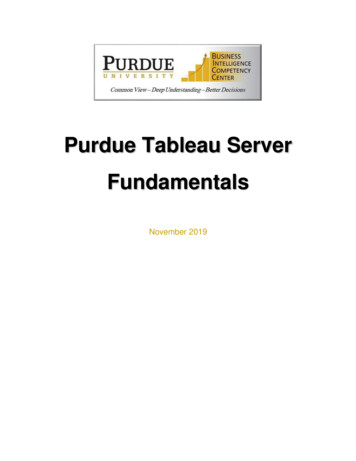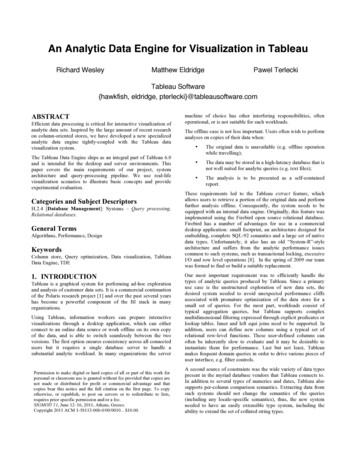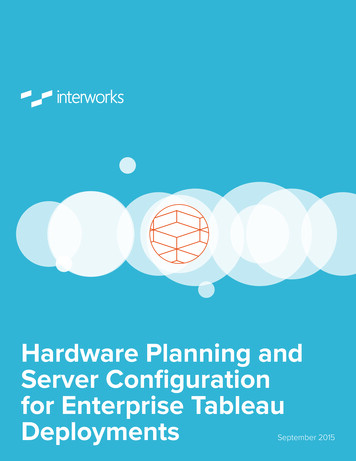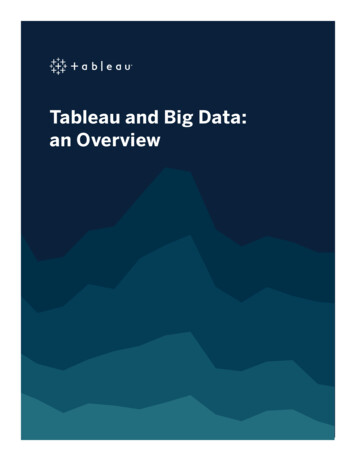
Transcription
Tableau and Big Data:an Overview
Table of ContentsWhat big data looks like today.3The evolution of data and demand for analysis.3Big data is both a promise and a peril.4How Tableau works with big data.5The big (data) picture.5Data access and connectivity.5Fast interaction with all data at scale.6Tableau and the big data analytics ecosystem. 7Cloud infrastructure.8Ingest and prep.8Storage and processing.9Query acceleration. 10Data catalog. 10Big data analytics architectures.10Major cloud provider examples.11Tableau customer examples. 12Common patterns. 13About Tableau & additional resources. 14Tableau and big data: an overview2
What big data looks like todayThe evolution of data and demand for analysisData is everywhere—so is the demand to access and analyze it. “Big data” as a buzzword may havesettled down, but the “three Vs” of big data—volume, variety, and velocity—apply more than ever tobig data analytics use cases. Though subjective, these and other Vs the industry has discussed (likevariability, validity, veracity, etc.) serve to remind us that big data today is still simply data—it’s justgotten so complex that organizations must innovate to effectively gather, curate, understand, and makeuse of it.Digital transformation is happening across every industry and all sizes of organizations with amultitude of “things” creating massive amounts of data in many formats and sources. Organizationsare collecting, processing, and analyzing more diverse data than ever before. From schema-free JSON tonested types in other databases like relational and NoSQL, to non-flat data—like Avro, Parquet, XML,etc.—data formats are multiplying and connectors are crucial to make use of them.Organizations often have a combination of the following: Structured data with precomputed aggregates to specific questions, perhaps pulled asextracts for in-memory computing, and aggregated for analysis. This is typically the mostrefined and easily accessible data an organization has. Semi-structured data (or object storage) perhaps in relational databases, data warehouses, ordata marts. Often, these are regularly refreshed business concepts for entity analysis—knownquestions with unknown answers—for example, transactions, opportunities, or actions takenby individual salespeople on opportunities. Raw, unstructured data in a data lake or cloud storage. This includes stream data created bysocial network feeds, IoT devices, and more. Data scientists may mine and transform this data,but its full potential is still unknown.While some data has yet to find its most valuable use cases, all of this data is met with a greater demandfor knowledge workers to access and analyze it for decision-making. The applications used for dataanalysis and visualization are gravitating toward the data itself. This means a large-scale shift towardsthe cloud, where analysis can occur alongside robust storage and data processing services that allow forgreater flexibility and scale. Whether an organization has an extensive, cloud-based big data practice oris currently doing very little analysis of their data, they can reap significant benefits by giving peopleacross business and IT departments the ability to visualize patterns and analyze for insights it contains.Tableau and big data: an overview3
In spite of modern analytics bringing broader capabilities to more business users of all skill levels,finding ways to make all of this data a useful resource for the entire organization presents manycomplex challenges. Business needs change as often as the data itself, necessitating a big data strategyand architecture that are agile and adaptable. Rather than building monolithic platforms with a focuson data connectivity, organizations would be wise to widen their scope of the big data opportunity andthink about its evolving analytics use cases. Otherwise they risk missing the bigger picture.Big data is both a promise and a perilData assets are increasingly becoming a key area of differentiation between wildly profitable andstruggling businesses. However the massive scale, growth and variety of data are simply too much andtoo expensive for relational database management systems to handle. In addition to hardware costsavings due to precomputation and shared computation, customers also seek to minimize moving theirdata around. Infrastructure that allows them to move data in the most agile ways will help to addressthe gap between raw, unstructured data and data that’s ready for users to analyze.Organizations also face issues with connectivity and performance. Even with options for liveconnections or in-memory analysis, huge data lakes can be heavy on operations to generate extracts, orto blend with other data. A modern and self-service approach to analytics has many promises of agility,but making massive joins on these datasets can choke up the system.IT and the business must work together, but with a bottom-up methodology comprised of subject matterexperts creating metadata, business rules, and reporting models. These processes must constantlyiterate and improve to meet the evolving needs of the business; in today’s era of digital transformation,the business won’t stand still, so your big data analytics framework shouldn’t either.Tableau and big data: an overview4
How Tableau works with big dataThe big (data) pictureEverything we do at Tableau supports our mission to help people see and understand their data. Tableauis the modern analytics platform for the digital economy because we fundamentally believe in thedemocratization of data. The people who know the data should be the ones empowered to ask questionsof the data, meaning knowledge workers of all skill levels should have the ability to access, analyze, anddiscover insights of their data wherever it may reside.As many customers are dealing with a diverse set of big data technologies, we have aligned ourengineering investments, partnerships within the ecosystem, and overall vision with the evolutionof the data landscape. Tableau has a rich history of investments ahead of the curve in big data. Theseinvestments include data connectivity to both Hadoop and NoSQL platforms, as well as large-scale onpremises and cloud data warehouses.We started off with a very narrow business use-case and then it justquickly spread. Tableau makes it simple and simplicity, everyone wantstalk about big data analytics but Tableau simplifies it.—ASHISH BRAGANZA, DIRECTOR OF GLOBAL BUSINESS INTELLIGENCE, LENOVOLearn how Lenovo increased reporting efficiency by 95% across 28 countriesData access and connectivityTo enable analysis of data of any size or format, we support broad access to data wherever it lives.Tableau supports over 75 native data connectors today as well as countless others through ourextensibility options. As new data sources emerge and become valuable to our users, we continue tointegrate and certify vendors’ connectors with Tableau, incorporating them into our product to lower thefriction for accessing data. We believe there is and always will be many sources of data that one personwishes to use—whether web traffic, records in databases, log files, and so on. SQL-based connections — Tableau uses SQL to interface with Hadoop, NoSQL databasesand Spark. The SQL that Tableau generates is standardized to the ANSI SQL-92 standard.Using SQL is powerful because it is extremely compact (one expression), it is open source andstandardized, there are no library dependencies and it is very rich and expressive. For example,using SQL, one can express join operations, functions, criteria, summarization, grouping andnested operations.Tableau and big data: an overview5
NoSQL interfaces — Just as the name implies, NoSQL (“not only SQL”) databases can havedata that is modeled in nonrelational in addition to relational formats, supporting additionalstorage types including column, document, key-value, and graph. It also means they cansupport SQL-like interfaces. ODBC — Tableau uses drivers leveraging the Open Database Connectivity (ODBC)programming standard as a translation layer between SQL and SQL-like data interfacesprovided by these big data platforms. By using ODBC, you can access any data source thatsupports the SQL standard and implements the ODBC API. For Hadoop, this includes interfacessuch as Hive Query Language (HiveQL), Impala SQL, BigSQL and Spark SQL. To achieve the bestperformance possible, we custom tune the SQL we generate as well as push down aggregations,filters, and other SQL operations to the big data platforms. Web Data Connector — With the Tableau Web Data Connector SDK, people to buildconnections to data that lives outside of the existing connectors. Self-service analytics userscan augment their big data analysis with outside data by connecting to almost any dataaccessible over HTTP, including internal web services, JSON data, and REST API.Fast interaction with all data at scaleWe want users to have access to all their data, at scale, to integrate with other data, and find insightsfast. To help make self-service, visual analytics possible with big data, Tableau has invested in severalpioneering technologies. Hyper data engine — Hyper is our high-performance in-memory data engine technologythat helps customers analyze large or complex data sets faster. With proprietary dynamic codegeneration and cutting-edge parallelism techniques, Hyper better utilizes modern hardwarefor up to 3X extract creation and 5X query speed than the previous Tableau Data Engine. Hypercan also augment and accelerate slower data sources by creating an extract of the data andbringing it in-memory. H ybrid data architecture — Tableau can connect live to data sources or bring data (or asubset) in-memory. You can go back and forth between these modes to suit your needs. Ourhybrid approach to accessing data brings a lot of flexibility for users and can help to optimizequery performance.Tableau and big data: an overview6
VizQL — At the heart of Tableau is a proprietary technology that makes interactive datavisualization an integral part of understanding data. A traditional analysis tool forces you toanalyze data in rows and columns, choose a subset of your data to present, organize that datainto a table, then create a chart from that table. VizQL skips those steps and creates a visualrepresentation of your data right away, giving you visual feedback as you analyze. VizQL allowsyou limitless exploration your data to find the best representation of it—and with unlimited“undo,” there is no wrong path. In this cycle of visual analysis, users learn as they go, addmore data if needed, and ultimately get deeper insights. It’s not only a richer experience, butone more accessible to all skill levels than to build dashboards by code.With Tableau, you can actually interact with the data set in real timeand you are able to analyze and then present it in the way that youwant within a few minutes.—JAMIE FAN, PRODUCT ANALYTICS LEAD, GRABLearn how Grab analyzes millions of rows of data to improve customer experiencesTableau and the big data analytics ecosystemA modern analytics platform like Tableau may be the key to unlocking big data’s potential throughdiscovering insights, but is still just one of the critical components of a complete big data platformarchitecture. Putting together an entire big data analytics pipeline can seem like a challenge in itself.The good news is that you don’t need to build out the whole ecosystem before you get started, nor do youneed to integrate every single component for an entire strategy to get off the ground.Tableau fits nicely in the big data paradigm because we prioritize flexibility—the ability to move dataacross platforms, adjust infrastructure on demand, take advantage of new data types, and enablenew users and use cases. We believe that deploying a big data analytics solution shouldn’t dictateyour infrastructure or strategy, but should help you to leverage the investments you’ve already made,including those with partner technologies within the big data ecosystem.Tableau and big data: an overview7
Cloud infrastructureOrganizations are increasingly moving business processes and infrastructure to the cloud. As cloudbased infrastructure and data services have removed some of the major hurdles faced with on-premisesHadoop data lakes, cloud-based big data analytics solutions are easier to implement and manage thanever before. Hadoop laid the foundation for the modern data lake with its powerful combination of low-cost,scale-out storage (Hadoop Distributed File System—HDFS), purpose-built processing engines (firstMapReduce, then over time Hive, Impala, and Spark), and shared data catalog (Hive metastore). Today, the once co-located storage and compute services can scale as needed and independently inthe cloud. Resources also scale up and down a lot more easily, and with on-demand pricing. Overall,the cloud makes for greater efficiency, management, and coordination of services.Learn more in this great article from Josh Klahr, VP of Product at AtScale.Tableau delivers key integrations with cloud-based technologies that organizations already use,including Amazon Web Services, Google Cloud Platform and Microsoft Azure.Ingest and prepIn modern ingest-and-load design patterns, the destination for raw data of any size or shape is often adata lake: a storage repository that holds a vast amount of data in its native format, whether structured,semistructured, or unstructured. Data lakes support modern big data analytical requirements throughfaster, more flexible data ingestion and storage for anyone to quickly analyze raw data in a variety ofways.Stream data is generated continuously by connected devices and apps located everywhere, such associal networks, smart meters, home automation, video games, and IoT sensors. Often, this data iscollected via pipelines of semi-structured data. While real-time analytics and predictive algorithmscan be applied to streams, we typically see stream data routed and stored in raw formats using lambdaarchitecture and into a data lake, such as Hadoop, for analytics usage. Lambda architecture is a dataprocessing architecture designed to handle massive quantities of data by taking advantage of both batchand stream processing methods. The design balances latency, throughput, and fault tolerance challenges.A variety of options exist today for streaming data including Amazon Kinesis, Storm, Flume, Kafka, andInformatica Vibe Data Stream.Tableau and big data: an overview8
Data lakes also provide optimized processing mechanisms via APIs or SQL-like languages fortransforming raw data with “schema on read” functionality. Once data has landed in a data lake, it needsto be ingested and prepared for analysis. Tableau has partners like Informatica, Alteryx, Trifacta, andDatameer that help with this process and work fluidly with Tableau. Alternately, for self-service dataprep, you can use Tableau Prep.Storage and processingHadoop has been used for data lakes due to its resilience and low cost, scale-out data storage, parallelprocessing, and clustered workload management. While Hadoop is often used as a big data platform, it isnot a database. Hadoop is an open-source software framework for storing data and running applicationson clusters of commodity hardware. It provides massive storage for any kind of data, massive processingpower, and the ability to handle extreme volumes of concurrent tasks or jobs.In a modern analytics architecture, Hadoop provides low-cost storage and data archival for offloadingold historical data from the data warehouse into online cold stores. It is also used for IoT, data science,and unstructured analytics use cases. Tableau provides direct connectivity to all the major Hadoopdistributions with Cloudera via Impala, Hortonworks via Hive, and MapR via Apache Drill.There will always be a place for databases and data warehouses in modern analytics architecture, andthey continue to play a crucial role in delivering governed, accurate, conformed dimensional data acrossthe enterprise for self-service reporting. Even companies who adopt other technologies (e.g. Hadoop,data lakes) typically retain relational databases as a part of their data source mixture. Snowflake is oneexample of a cloud-native SQL-based enterprise data warehouse with a native Tableau connector.Object stores, such as Amazon Web Services Simple Storage Service (S3) and NoSQL databases withflexible schemas can also be used as data lakes. Tableau supports Amazon’s Athena data service toconnect to Amazon S3, and has various tools that enable connectivity to NoSQL databases directly.Examples of NoSQL databases that are often used with Tableau include, but are not limited to, MongoDB,Datastax, and MarkLogic.The data science and engineering platform Databricks offers data processing on Spark, a popular enginefor both batch-oriented and interactive, scale-out data processing. Through a native connector to Spark,you can visualize the results of complex machine learning models from Databricks in Tableau.Tableau and big data: an overview9
Query accelerationWhile you can perform machine learning and conduct sentiment analysis on big data, the first questionpeople often ask is: How fast is the interactive SQL? SQL, after all, is the conduit to business users whowant to use big data for faster, more repeatable KPI dashboards as well as exploratory analysis.This need for speed has fueled the adoption of faster databases leveraging in-memory and massiveparallel processing (MPP) technology like Exasol and MemSQL, Hadoop-based stores like Kudu, andtechnologies that enable faster queries with preprocessing like Vertica. Using SQL-on-Hadoop engineslike Apache Impala, Hive LLAP, Presto, Phoenix, and Drill, and OLAP-on-Hadoop technologies likeAtScale, Jethro Data, and Kyvos Insights, these query accelerators are further blurring the lines betweentraditional warehouses and the world of big
of the data landscape. Tableau has a rich history of investments ahead of the curve in big data. These investments include data connectivity to both Hadoop and NoSQL platforms, as well as large-scale on-premises and cloud data warehouses. We started off with a very
